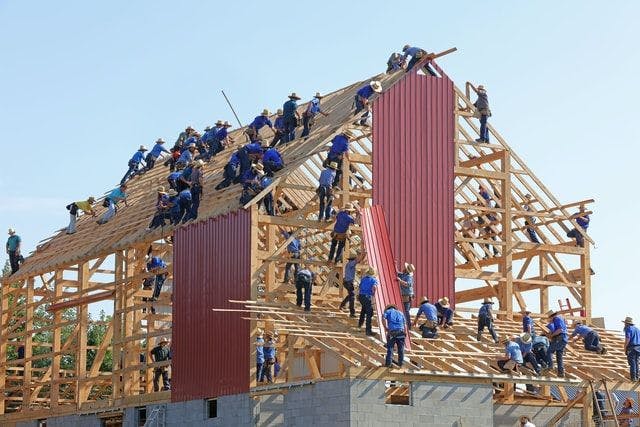I have been involved with emerging technologies and their adoption in large companies for almost three decades. In my experience, the adoption cycle of new technologies follows a pretty typical pattern. At the onset, as the new technology gets past the “better than sliced bread” phase, companies start to go through early pilots to understand the applicability to the technology in their organizations. The pilot phase usually also provides the opportunity to conduct activities related to a proof of concept to validate the robustness and maturity of the technology platform. Following this, the development of a roadmap is the typical next step with the identification of a possible first project that can leverage the new technology. This process of vetting, POC, and roadmapping can take months and sometimes even years.
What follows this initial project is usually the continued methodical evolution of the capability in the organization over a multiyear period.
The evolution can be mapped to the attainment of certain levels of maturity on a typical multi-stage maturity model. The progression along this maturity model includes the development of a Center of Excellence (COE) for the new technology capability. In my experience, the launch of these types of COEs that organize the skills, artifacts, tools, etc. related to the new capability usually don’t enter into the picture until the later stages of maturity have been attained, i.e on the later stages of the maturity model. With this context in mind, I have made these two observations about how the adoption of Robotic Processes Automation (RPA) has followed a somewhat different progression on the adoption journey in organizations.
- The time spent in the early stages of the maturity cycle is much shorter
- The formation of a COE happens a lot quicker

Core Capabilities of a RPA COE in the Enterprise
Here is my thesis for why RPA adoption has this distinctly different path. Let's discuss both these points in more detail.
- Due to the nature of RPA, where the technology itself is not very complex, proving out the technology is not a meaningful exercise. The proof of the business value potential is a more meaningful concept in this case - Proof of Value vs. Proof of Concept.
- As a corollary to the above, business teams are asking for a fairly robust RPA capability to be available for them to leverage as they start to look for ways to find use cases that can be candidates for automation. An RPA COE can organize this capability and make it available to the business teams in a structured platform.
- Business functions are engaging RPA vendors on their own and IT runs the risk of being left out unless they “get with the program”. To avoid losing control of the RPA program, IT organizations are responding by accelerating the COE formation to organize RPA related business initiatives.
Core Capabilities of an RPA COE in the Enterprise
The RPA COE needs to provide some key capabilities:
- Provide an easy way to identify the first set of processes for automation. The identified processes must have a fairly high business benefit and a low to medium complexity of implementation.
- Provide the common math to calculate the Automation Potential (calculated as a function of business benefit and complexity of implementation) and a uniform way to apply this math to all business functions.
- Beyond the first set of use cases, provide a way to capture RPA ideas from the organizations.
- Maintain a clear view of the Planned ROI vs. Realized ROI to confirm the proof of value.
- Provide an organization-wide view of the RPA pipeline of deployed, in progress and planned bots.
- Technical capabilities and capacity to build, deploy, monitor and refine the bots.
- Provide acceleration with the use of reusable components that can be leveraged by the automated bots.
- Provide the software and hosting infrastructure along with the associated capabilities to monitor and manage this as a shared resource across the organization.
- Standardize the RPA platform, the SDLC platform, artifact templates, standard methodology for operational reporting.
- The rules of engagement and the governance structure.
Most of this sounds like a page out of a COE launch playbook, doesn't it? So, are you ready to go ask for the budget, get the needed buy-in, and build yourself an RPA COE? I would suggest, you absolutely should not. It is my strong recommendation that organizations should look to partner with a provider that can provide this as an “RPA COE in a box". Why is that?" you ask, especially, when COEs are not a new or novel idea for many companies. I will submit the three reasons why building one on your own internally is a suboptimal way to do it. First, An enterprise-grade COE needs to be stood up fast. Secondly, organizations need to focus their efforts on capturing the benefits of automation rather than on building the capability that can help capture the benefit. And finally, the ongoing operation of an internally operated COE is not cost-effective.

Benefits of an Outsourced COE
Let's dive deeper into some of these benefits that are a part of the strategy to outsource the RPA COE:
- Fast ramp-up - an RPA-as-a-Service (RPAaaS) offering can help get your RPA COE stood up in a very short time - with a good RPAaaS provider this can be a matter of fewer than a couple of weeks. To provide a frame of reference, at Optezo we can do this in less than a week. We apply a practiced approach through the use of the Optezo RPAaaS Playbook, This Playbook is a distillation of our extensive experience with enterprise COEs.
- Reduced cost of ongoing operation - The business case of RPA is heavily dependent on the reduction of the cost of the effort that goes into developing and operating the automations. Economies of scale from shared infrastructure, reduction in development cost from reusable and pre-built components, and lower cost of operation through a skilled team are critical levers to impact the cost of operation.
- Laser focus on increasing business benefit - Offloading the mechanics of operating the RPA COE to the RPAaaS provider is huge. It frees up the internal resources to focus more time on defining the automations. The internal team can refine each iteration using an iterative process, to the point of diminishing returns, before moving on to the next set of automations.
- Scale and capacity throttling - The outsourced COE model can add instant scale to the RPA capability. This can be hugely beneficial in the form of higher throughput for the automation backlog. Plus the added benefit of being able to add or remove capacity to match the ebb and flow of the automation efforts.
- Access to expertise and knowledge - Experienced outsourced RPA teams can add two types of expertise to the RPA COE: 1) The business expertise to guide the identification of use cases for automation. 2) The technical expertise to architect, build, and operate the RPA platform.
- Simplified billing and preferred cost accounting - the outsourced model based on RPAaaS provides a very simple way to consume this capability. You pay for maintaining the base level of capability using a monthly billing model and when needed, the cost of the additional capacity; resources, licenses, and infrastructure, can be added based on the spike in demand. The RPAaaS model also has the added benefit of favorable OpEx vs. CapEx treatment. You can ramp the cost in line with the benefit rather than a large upfront capital expense.
The right RPAaaS provided for your RPA COE
With these considerations in mind, we built the Optezo RPAaaS capability for our customers. The "RPA COE in a box" benefits from the following Optezo RPAaaS components.
- Optezo Process Catalog
- Optezo Component Library
- Optezo RPAaaS Playbook
- Optezo ROI Dashboard
For more information on the Optezo RPAaaS Playbook, check out my blog post here. Ready to get going with RPAaaS? Talk to us today!
